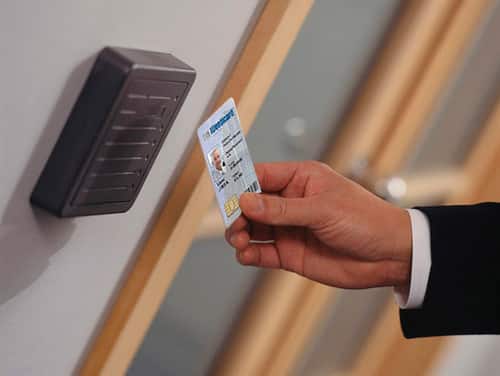Access Control
Access Control—It Has to be Done Right To Be Effective

A study keypad lock is a reliable and hard-wearing choice for access control on an exterior office door.
The door of your home or office is the first line of defense, and properly controlling who does or doesn’t get in is the first challenge a door access control system has to meet. To do this, the system has to do several things flawlessly: authorize access for the people who belong, refuse access for those who don’t, and keep a record of who has passed through the access point for later reference.
Setting up your access control systems to do this takes forethought and finesse, which is why it helps to consult with professionals who specialize in high-tech security before you install your new system.
Front Gate Access Control
The gate around your property is the first barrier a visitor (or intruder) has to pass to gain access to your property. If you don’t have a gate, then the first control point is your building’s front door. Access control systems at these exterior points are exposed to both the infamous Florida weather and to forcing attempts by unauthorized people. Sensitive electronics are usually too vulnerable for this work, which is why exterior access control points typically use robust technology, such as keypad locks, which generally can’t be forced and rarely fall victim to heavy rain or other environmental elements.
Protect Interior Spaces

Electronic card readers are a great option for interior doors.
Once a visitor enters your premises, you may still wish to control his access to certain sensitive points within. Here, in the controlled environment of your office, you have many options to enhance security. Though keypad locks are still commonly used indoors, interior access control often employs electronic door locks that are controlled by fingerprint scanners or card readers.
Fingerprint locks use the print on the right thumb or forefinger to verify a person’s identity. This system is hard to spoof, and the price of a reliable laser scanner system has come down considerably in recent years making it perfect for budget and security conscious property owners.
Card readers are great because they grant or deny access based on the code embedded within the magnetic strip on a key card or key fob. This is very affordable, due to the simplicity of the design, but the system is vulnerable to anyone who manages to obtain an authorized card. That is why a pin pad is recommended in addition to the card reader. This means the door will not open without dual authentication. The electric strike mechanism holding the door closed can be set to either lock or unlock the door in the event of a power failure, depending on your needs.
CCTV Surveillance Systems

CCTV cameras can be mounted outside or inside your property and can be set to record constantly or can be triggered by the motion of someone walking past.
Many security systems incorporate security cameras that feed to a guard station or recording device as an added layer of control. CCTV systems may be continuously on, or they may be triggered to record when a proximity reader is activated. When manned, these systems add the element of human judgment to access control decisions, with all the strengths and weaknesses that brings. When unmonitored, camera systems produce a video record of people on the property that can later be used to identify suspicious persons. These systems will work in conjunction with your door hardware, locks, and safes.
Whatever the details of your access control system, it’s vital to consult with professionals in the field before you get started. Since 1982, Bayfront Central Security & Systems Group has provided that expertise to homeowners and businesses in the St. Petersburg area. Call your local security experts for an evaluation of your needs to determine which systems are right for you, as well as to get helpful information on setting up and maintaining the systems you put in place.
